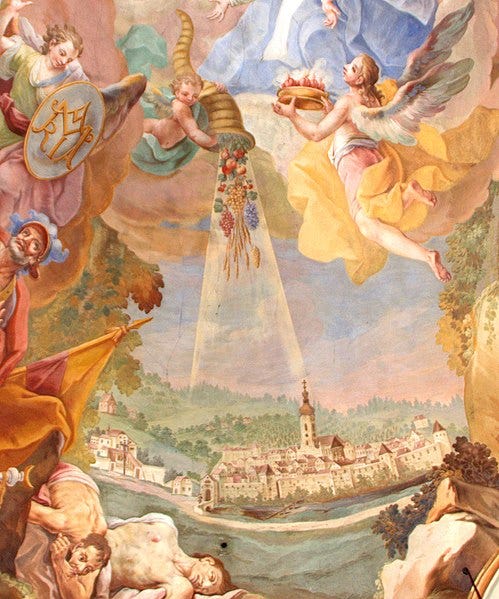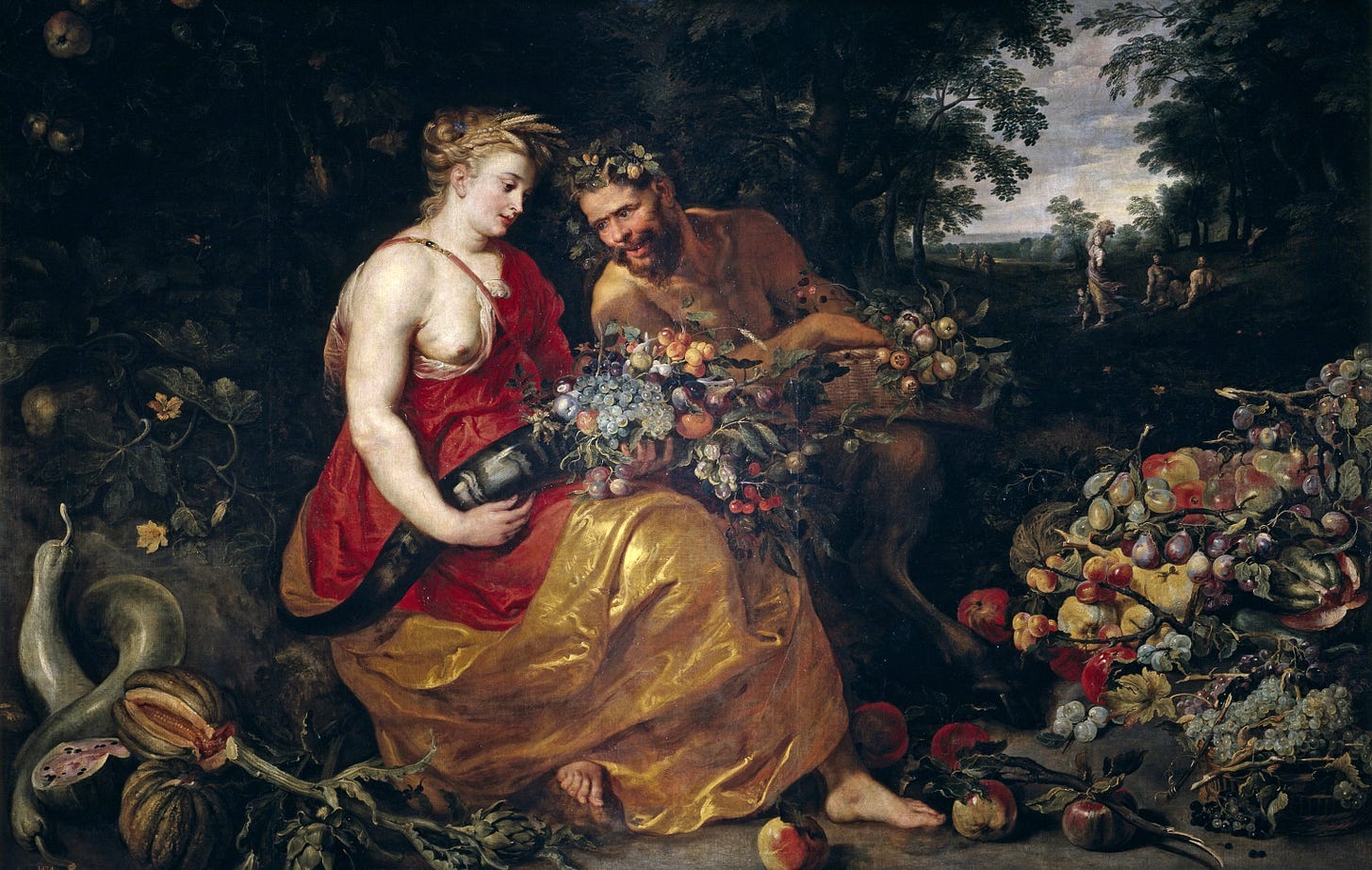Reclaiming Cornucopianism
The horn of plenty as a symbol for progress studies and techno-optimism 🐚
I learned a fun new word the other day: cornucopianism. It comes from cornucopia, the horn of plenty, a magical artifact that comes up occasionally in Greek myth and comes up a rather great deal in the Western art tradition. The story goes that the horn of plenty was broken off from a goat goddess who fed Zeus during his infancy, or from a river god who had been temporarily turned into a bull. Either way, it provides an endless flow of resources — grain, fruits, vegetables, flowers, and more rarely coins and jewelry.
Where does the horn of plenty get those resources, the myth doesn’t say. It’s magic. Overflowing abundance that just materializes out of thin air.

Cornucopianism refers to the idea that the horn of plenty is real, except it’s not shaped like a horn. Instead it’s shaped like a human brain. By using our intellect and creativity, we are able to generate large amounts of almost any resource we may want — or, in the cases where we can’t, figure out a suitable replacement. Thus virtually every past prediction of resource shortage has ended up being a non-issue. When oil seems to be running out, we find more oil, or develop new chemicals to substitute it.
Relatedly, every prediction of crisis due to overpopulation (which depletes resources) has turned out to be wrong. The more humans exist, the more there is intellect and creativity around to find solutions. People who believe in cornucopianism — cornucopians — believe that this will continue indefinitely.
The sworn enemy of cornucopianism is, of course, malthusianism. Malthusians posits that the horn of plenty, like all magical artifacts, doesn’t exist. Or at least, that it isn’t literally infinite. Sure, they’ll concede that cornucopians have appeared to be right several times, especially since the industrial revolution. But at some point, we are bound to hit the limits. “There cannot be infinite growth on a finite planet,” they’ll say. And then, when we are actually overpopulated, and there is neither any oil/water/arable land/etc. nor anything that can replace it, things will get ugly.
If you’ve given any thought at all about technological trends, there’s nothing groundbreaking about any of this. The cornucopians are techno-optimists or progress studies people; the malthusians are techno-pessimists or doomers. Different words for the same big debate.
But I do find the metaphor of the cornucopia interesting. I want to dwell on it a bit.
I haven’t been able to find when the word “cornucopianism” came into existence, but it might have been in the 1980s, since it is associated with the economist Julian Simon, who wrote The Ultimate Resource in 1981. (The “ultimate resource” is human invention.) In any case, the term is legit enough to have its own wikipedia page. It does seem, however, that almost nobody calls themselves a cornucopian. Instead the word is slightly derogatory and used mostly by opponents. One of those opponents is the philosopher or science Naomi Oreskes, who used it for instance in an article from last year titled “Eight Billion People in the World Is a Crisis, Not an Achievement.” I personally learned the word from an article (in French) that was also highly critical.1
It’s not very hard to guess why “cornucopianism” is more often a term of mockery than a rallying banner for techno-optimists. The horn of plenty is a magical artifact! It’s obviously not real! You’d have to be naïve to believe in a horn that materializes produce out of nowhere, lol

But let’s think a bit about what “magic” means. I’ve written before that magic only refers to things, whether fictional or real, that are not understood. When something is understood, we call it technology instead (if it’s man-made) or a scientific discovery (if it’s natural). Crops that grow twice as fast as you expect, for mysterious reasons, are magic; crops that grow twice as fast because you provided them with fertilizer, which was made by workers in a chemical factory, are the result of technology.
So a horn of plenty is magical only if we don’t understand how it works. If you get a horn of plenty from your local goat goddess and open it up and figure out its mechanism, then it’s not a magical artifact; it’s just a useful natural resource or technological device. And it follows that we should figure out how to farm those goat goddesses, harvest their horns, and sell them to everyone on Earth.

Less allegorically, if we suspect the human capacity for progress to be a source of endless growth, then we should figure out how that works and make sure it works well. The good news is, this is exactly the program of the progress studies movement.
One thing that’s great about progress studies and techno-optimism is its total rejection of the magic metaphor. In an old post I wrote that we can do better than miracles: innovation should basically never be seen as something incomprehensible that “just happens” thanks to outside intervention.
A minor problem with this is that the people love magic metaphors. Technology is often incomprehensible to the average person, which makes the average person likely to nod along when a techno-pessimist malthusian philosopher of science declares that “it’s foolish to wait for a magical solution to address climate change / resource shortage / whatever.”
So I wonder if it’s time for techno-optimists to reclaim the use of magical metaphors. Not in the sense of saying that things are incomprehensible, but in the sense of infusing technological progress with an appealing aesthetic. Saying, “yes, it’ll take a miracle to solve climate change, and we’ll fucking make the miracle happen because we’re badass humans who have an amazing intellect and creativity.”
Some companies do this already, and generative AI functionality has been getting this treatment in the form of sparkly icons. But on the philosophical side of things, maybe it’s time for techno-optimists to call ourselves cornucopians. To say, boldly, “yeah, that magical horn that just creates endless resources out of thin air? We’re making it.”

I don’t find the criticism to be very good. For instance, some of it (especially in that Naomi Oreskes article) focuses on how cornucopianism is often associated with free markets and libertarianism. Yet, Oreskes says, a lot of innovation historically came from governments! Checkmate, cornucopians!
That seems pretty weak to me. Governments have been a pretty major part of society for centuries, so it’s expected that they’d be responsible for a lot of changes, including technology. Besides, even though I understand and agree with the idea that free markets are better for progress, I don’t see why you couldn’t be a cornucopian and a fan of big government intervention. Attacking cornucopianism on the grounds that it’s libertarian is missing the point.
In that other article, one of the arguments against cornucopianism is that nuclear energy plateaued after the 1970s, contrary to cornucopian predictions. That seems hilariously self-unaware, considering that it’s exactly the opposite of cornucopian thought — overregulation and fear of technology — that led to decreased investments in nuclear power plants.







From now on I’m calling myself a cornucopian! We do need to reclaim the magic!
Very nice. I'd only point out that the real Malthus is poorly served by catastrophist neo-Malthusians. As far as I'm aware, Malthus's theory was about how causes both natural and man-made tended to keep population in balance; i.e. not a catastrophe at all. But I know it's all very controversial.